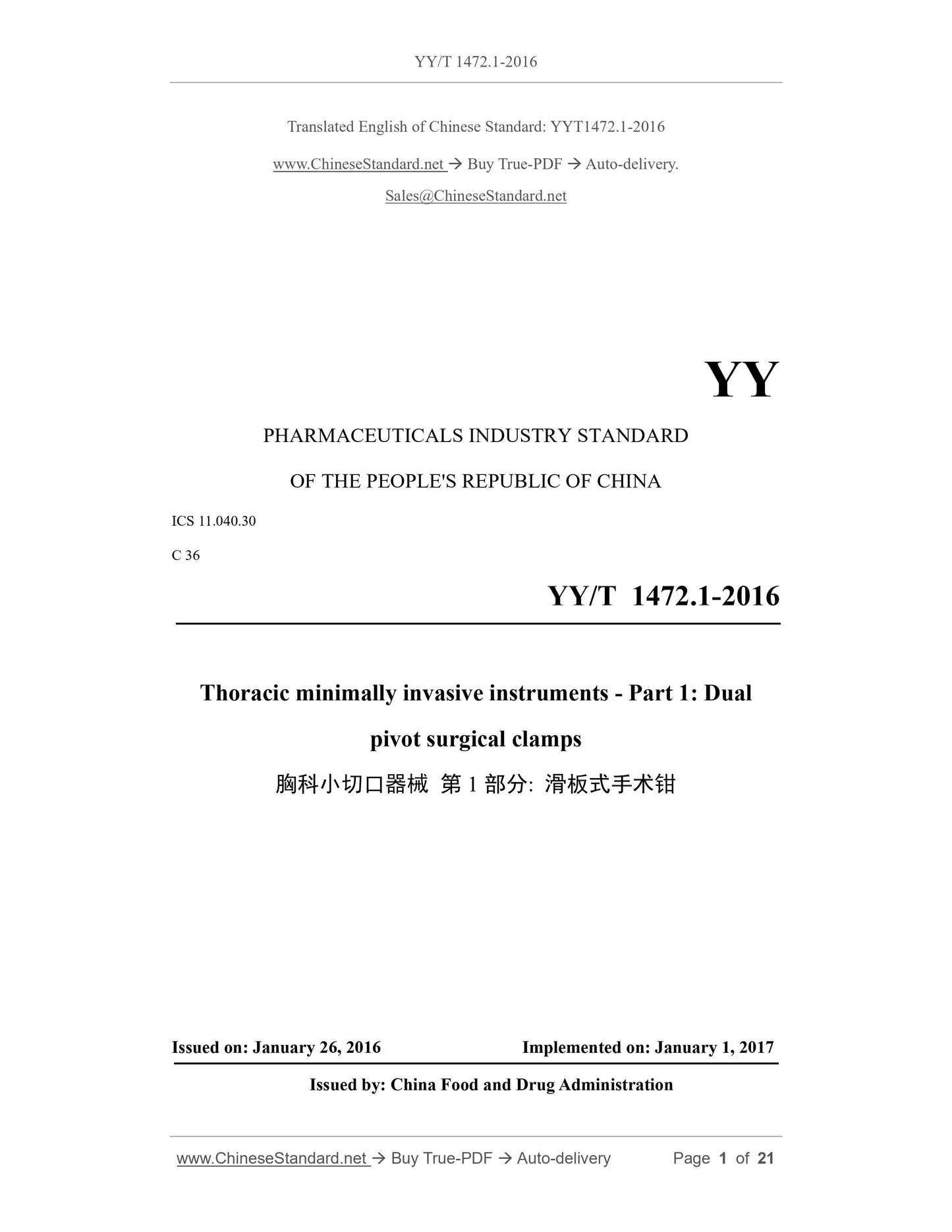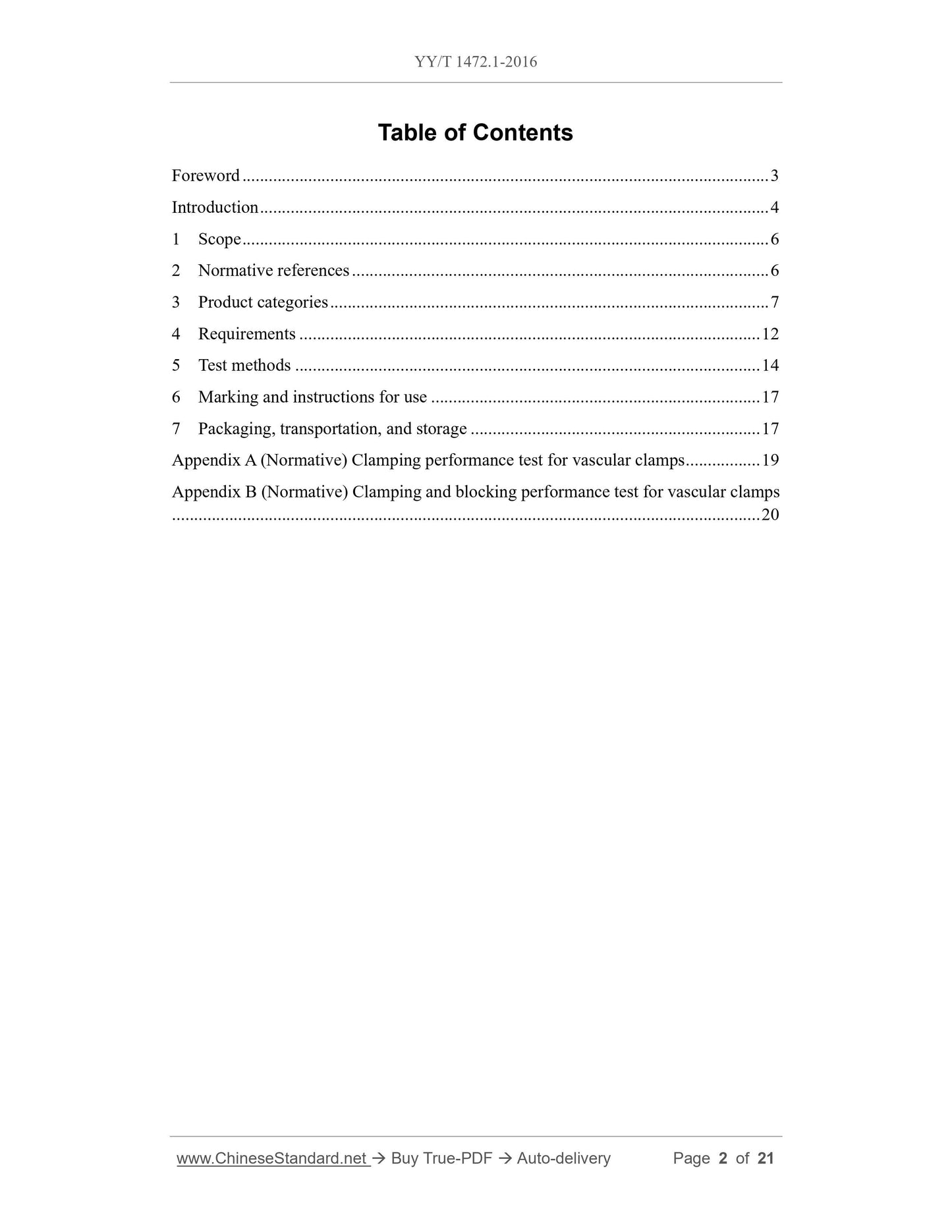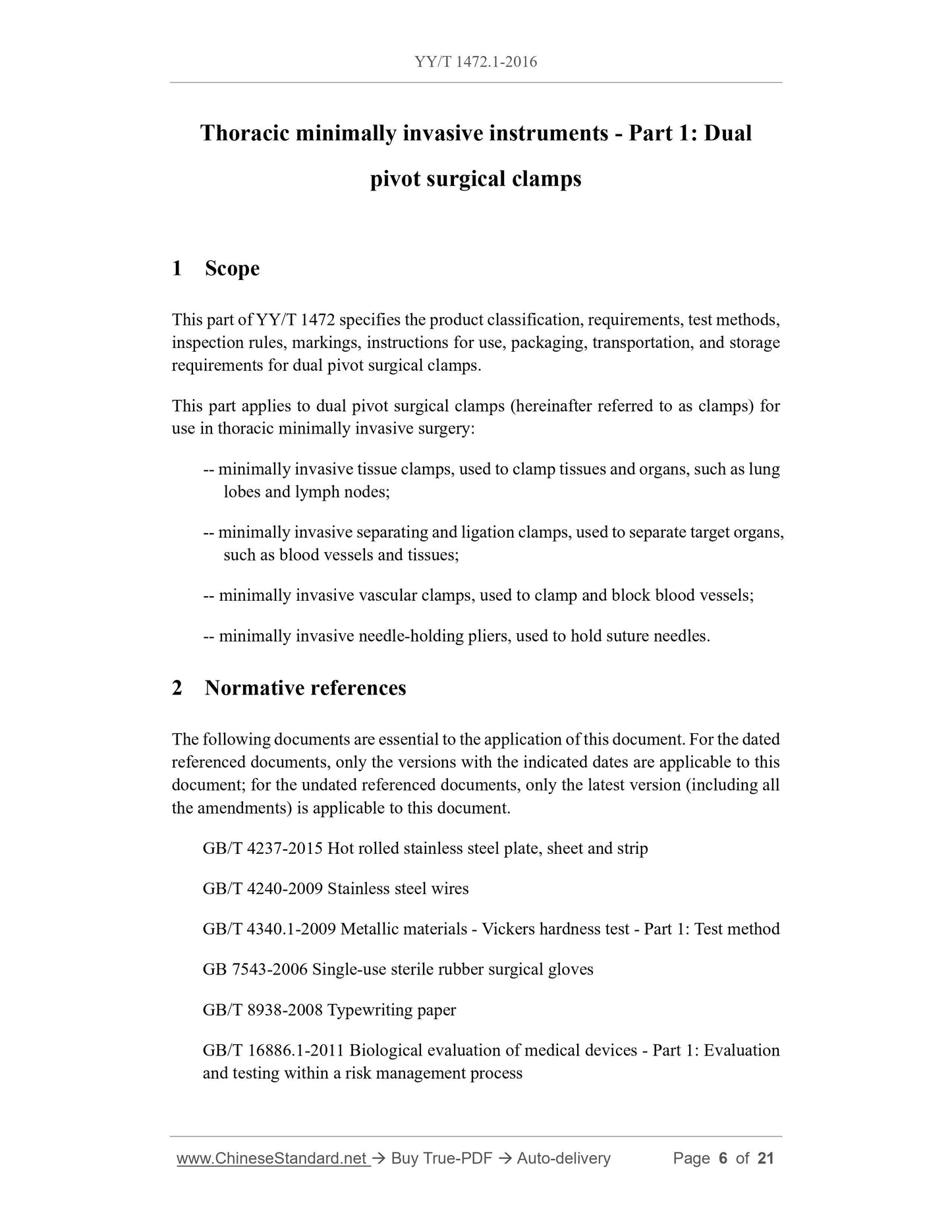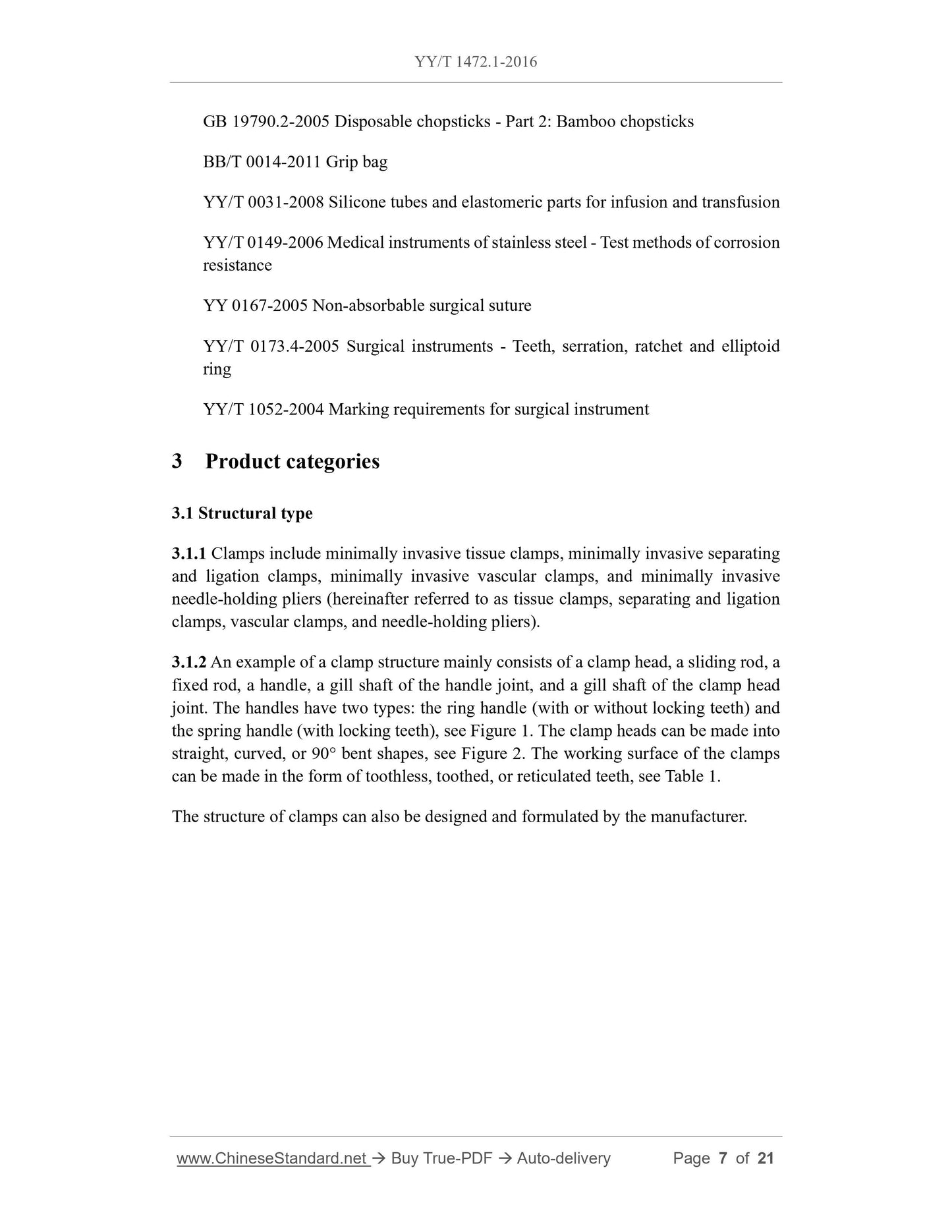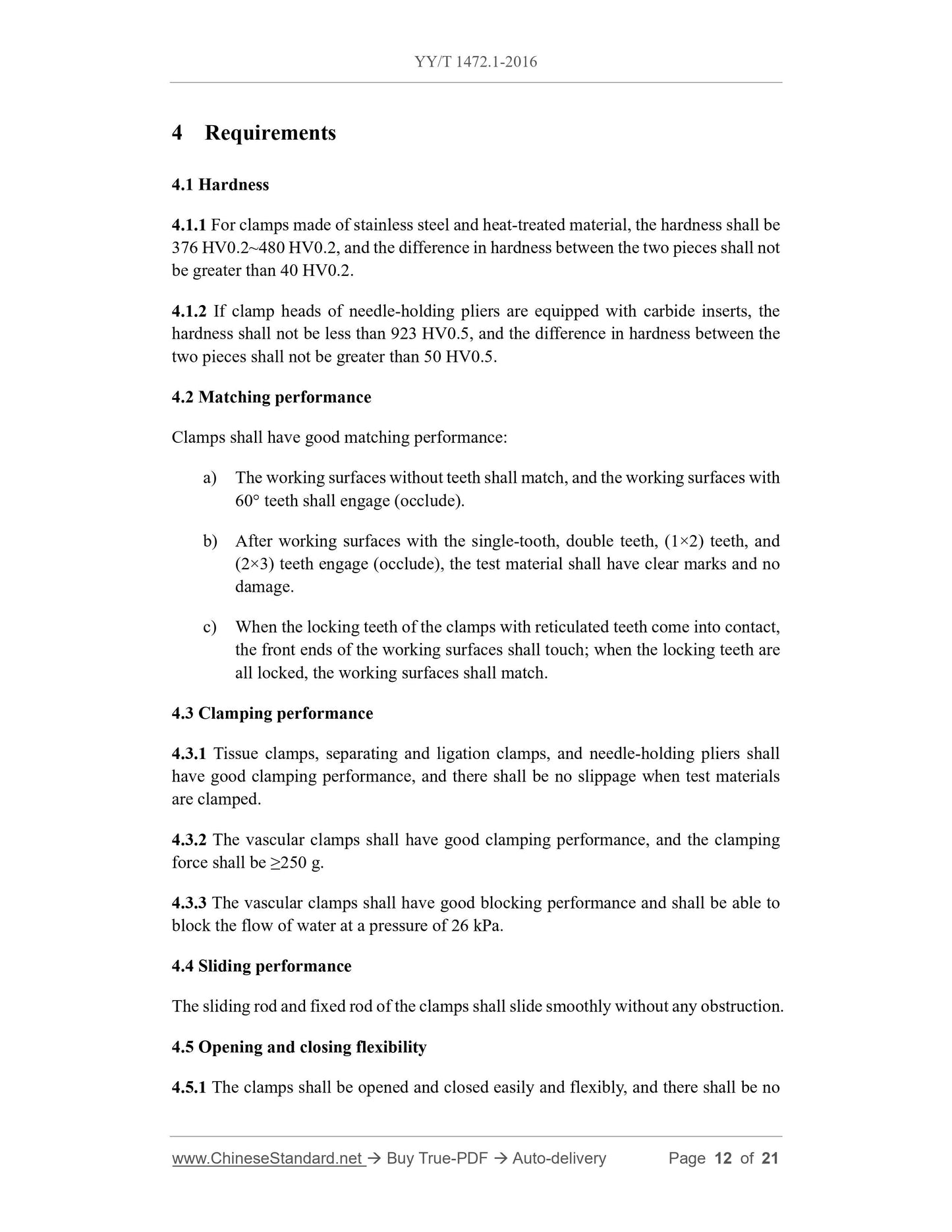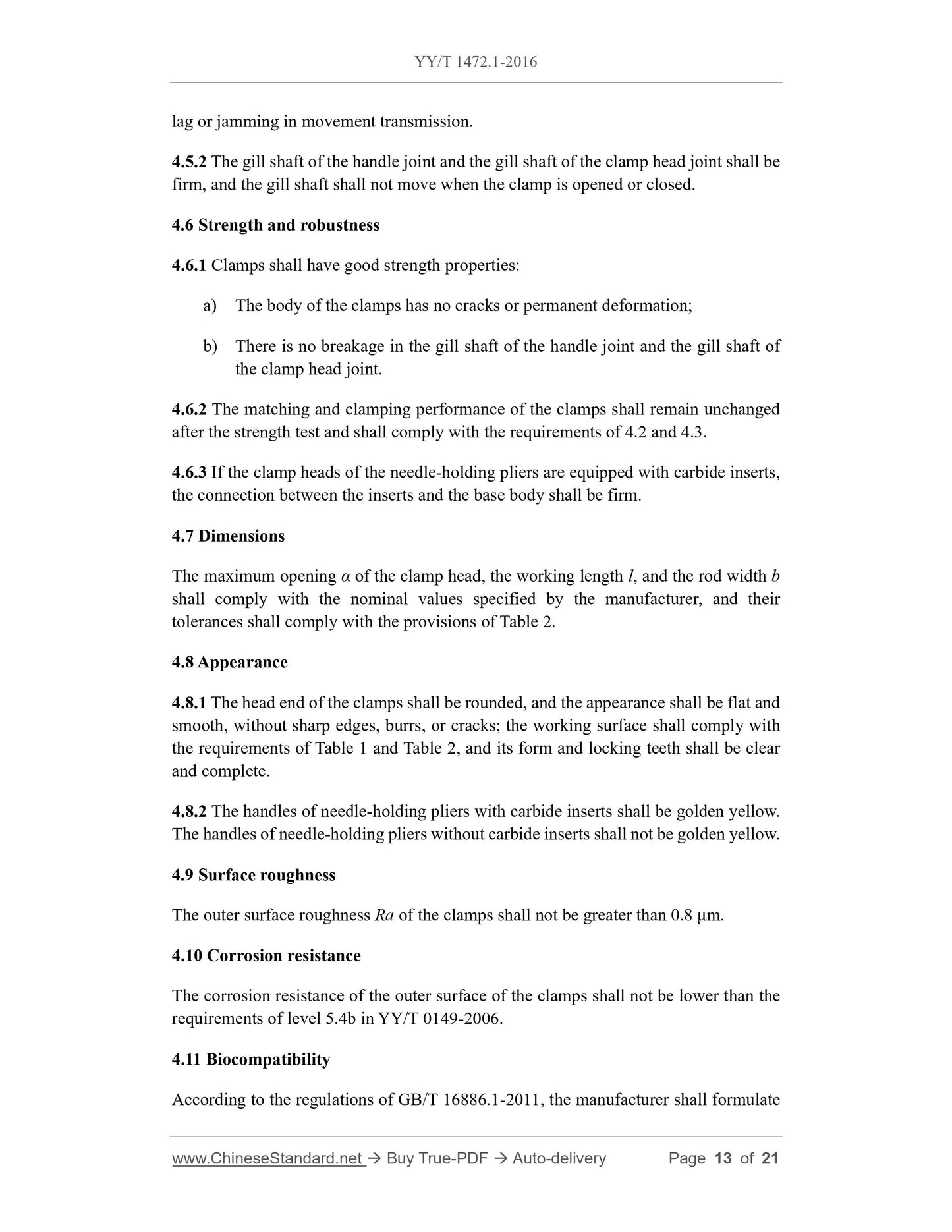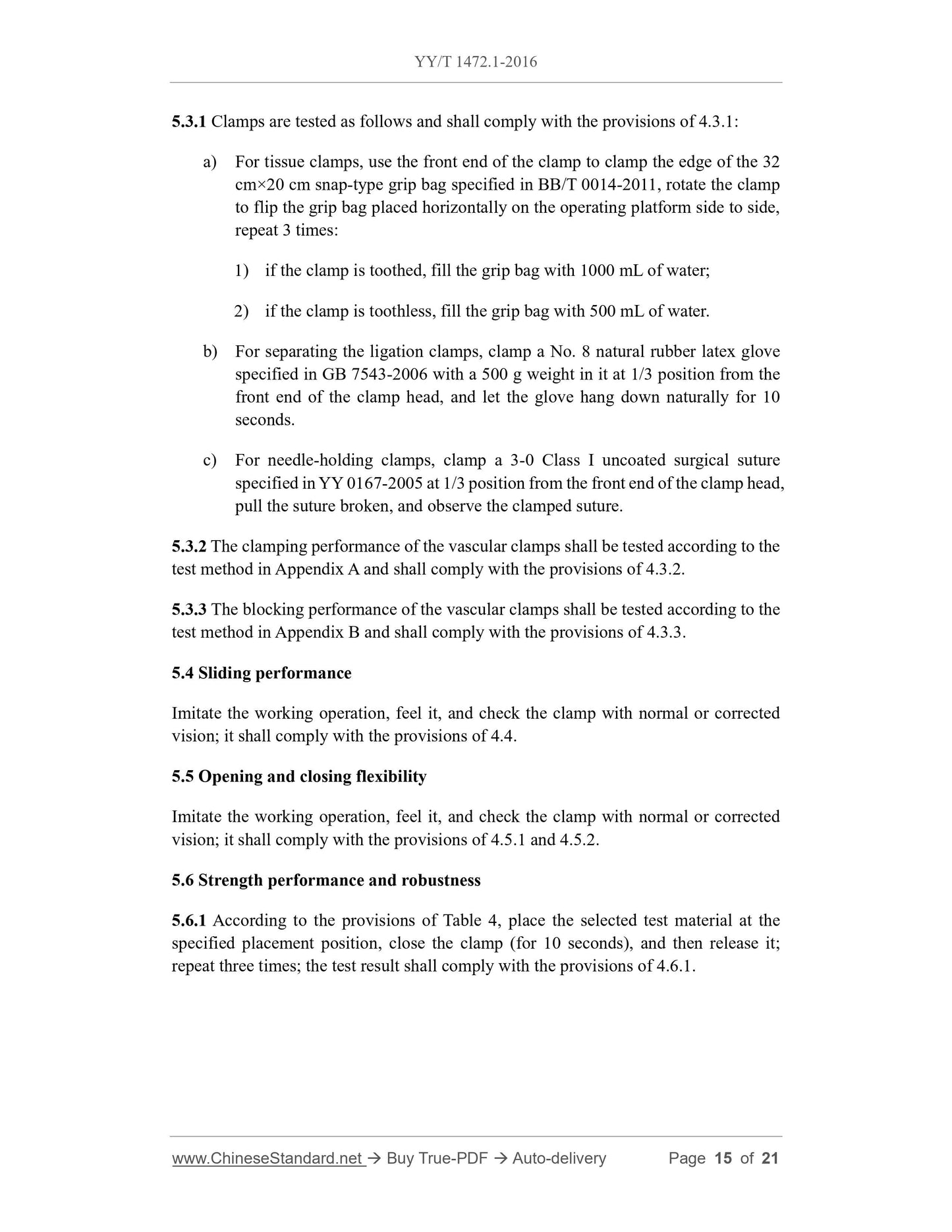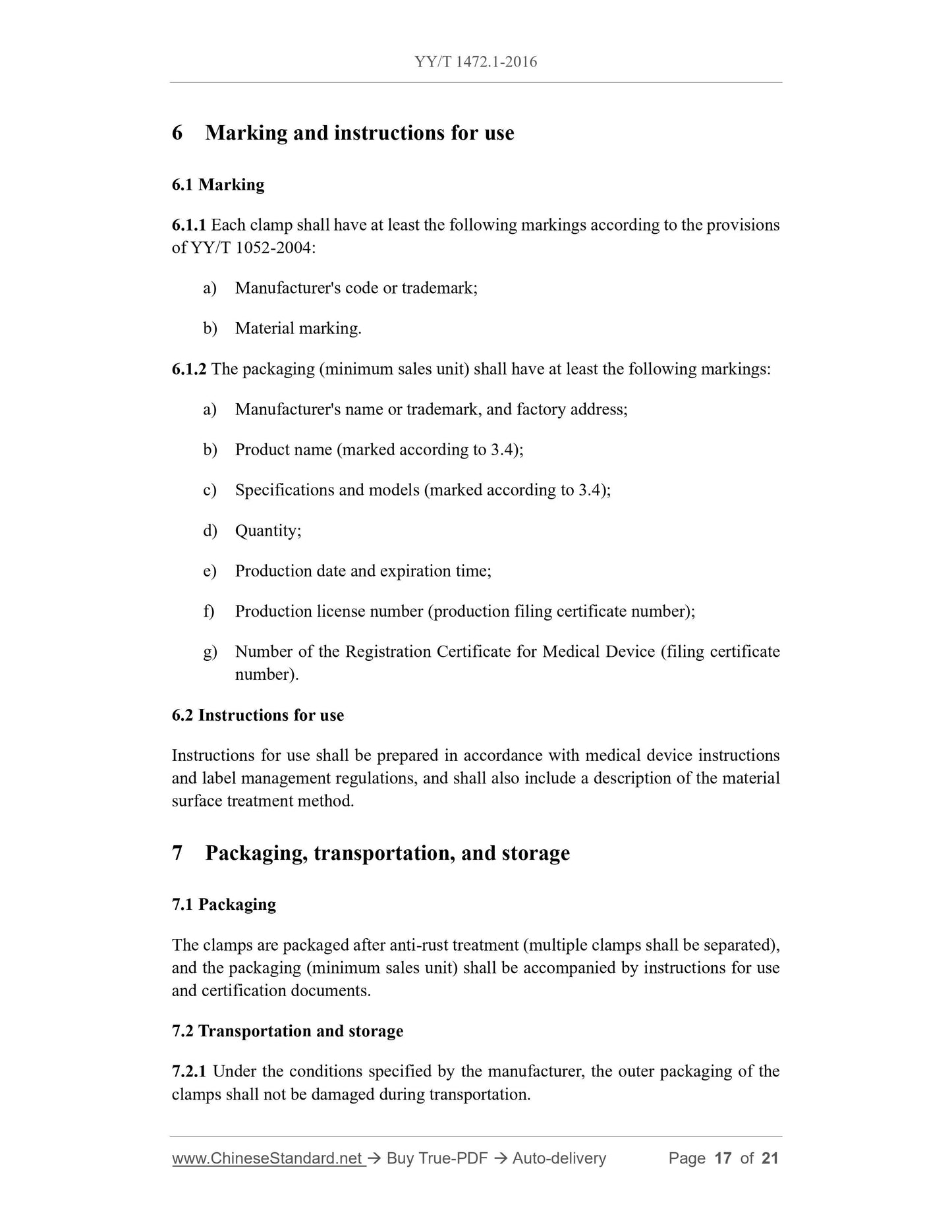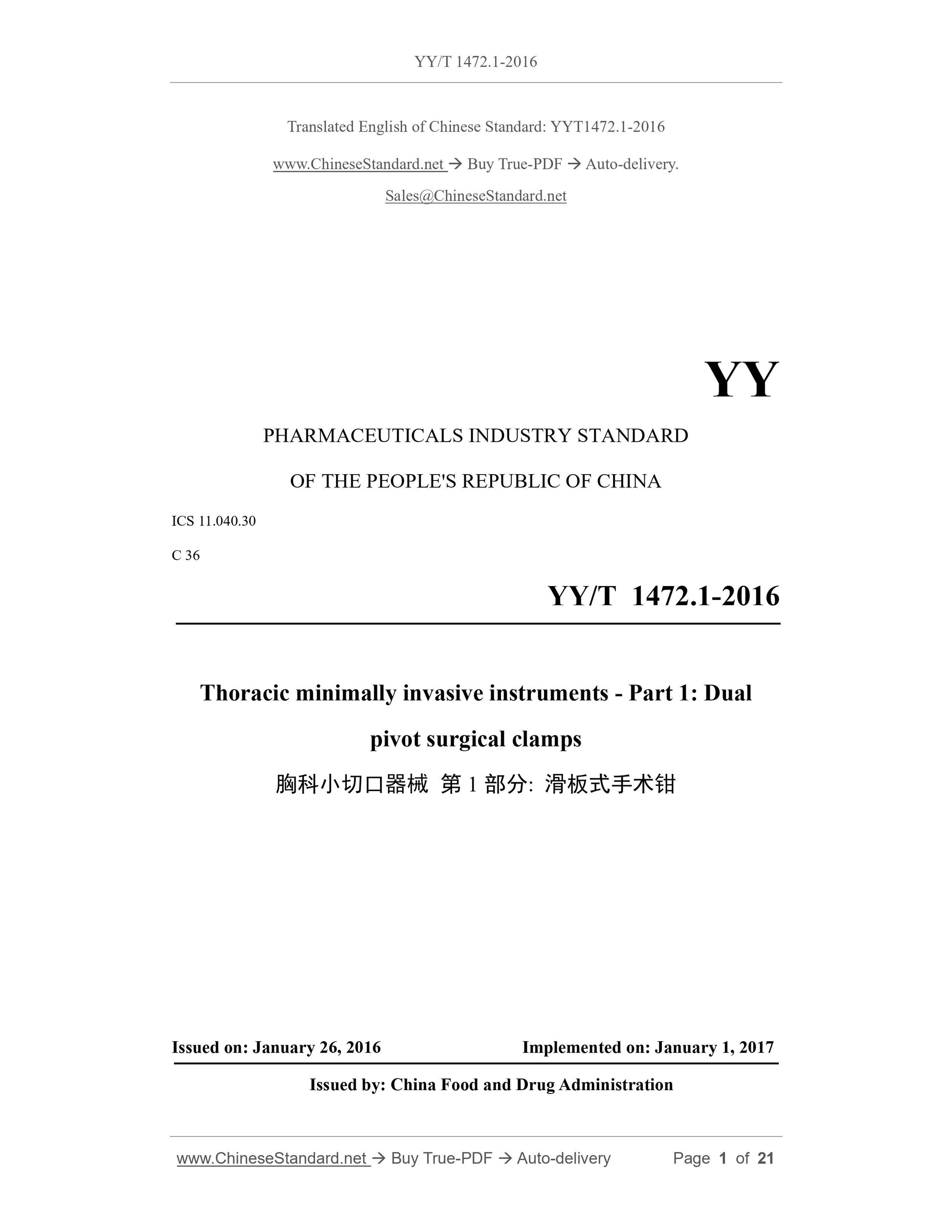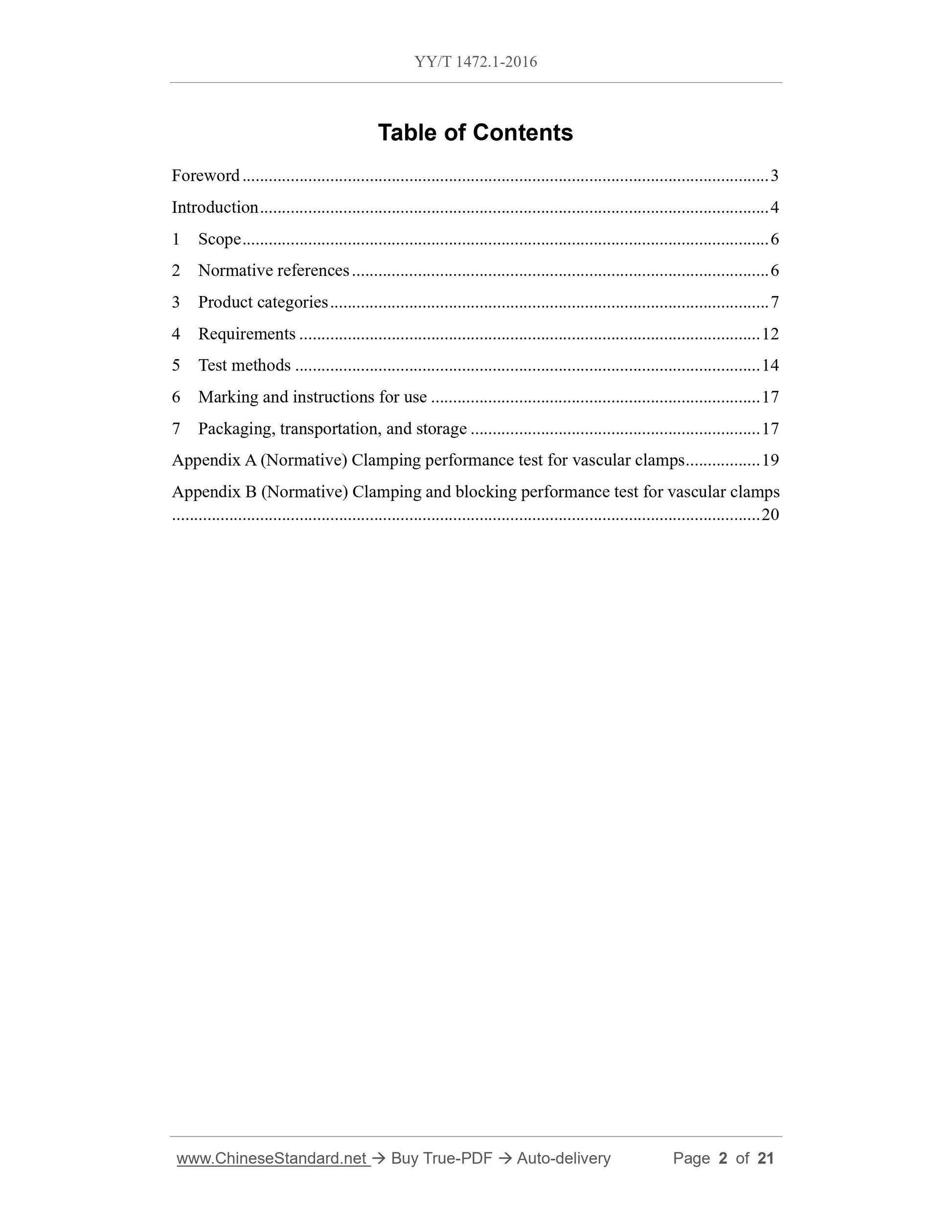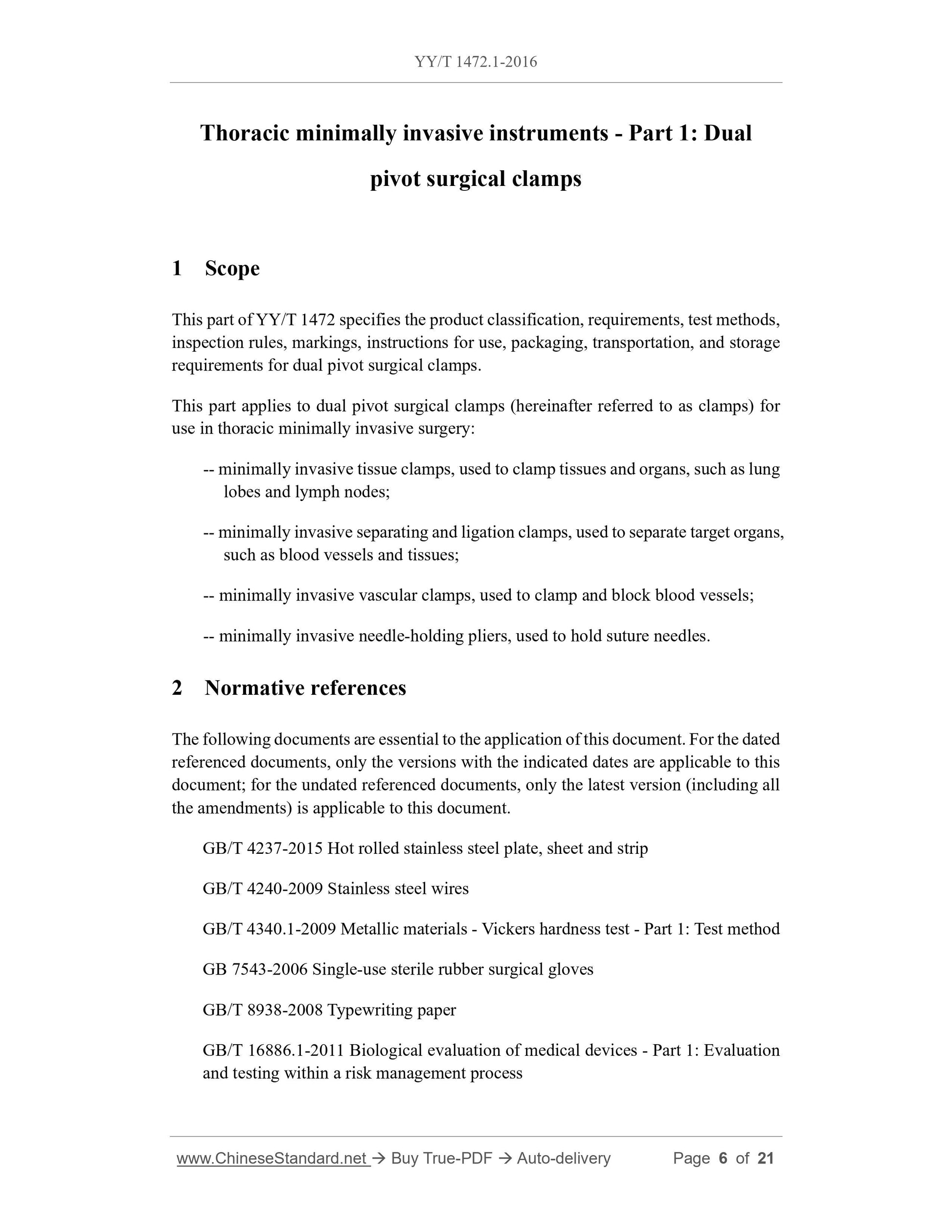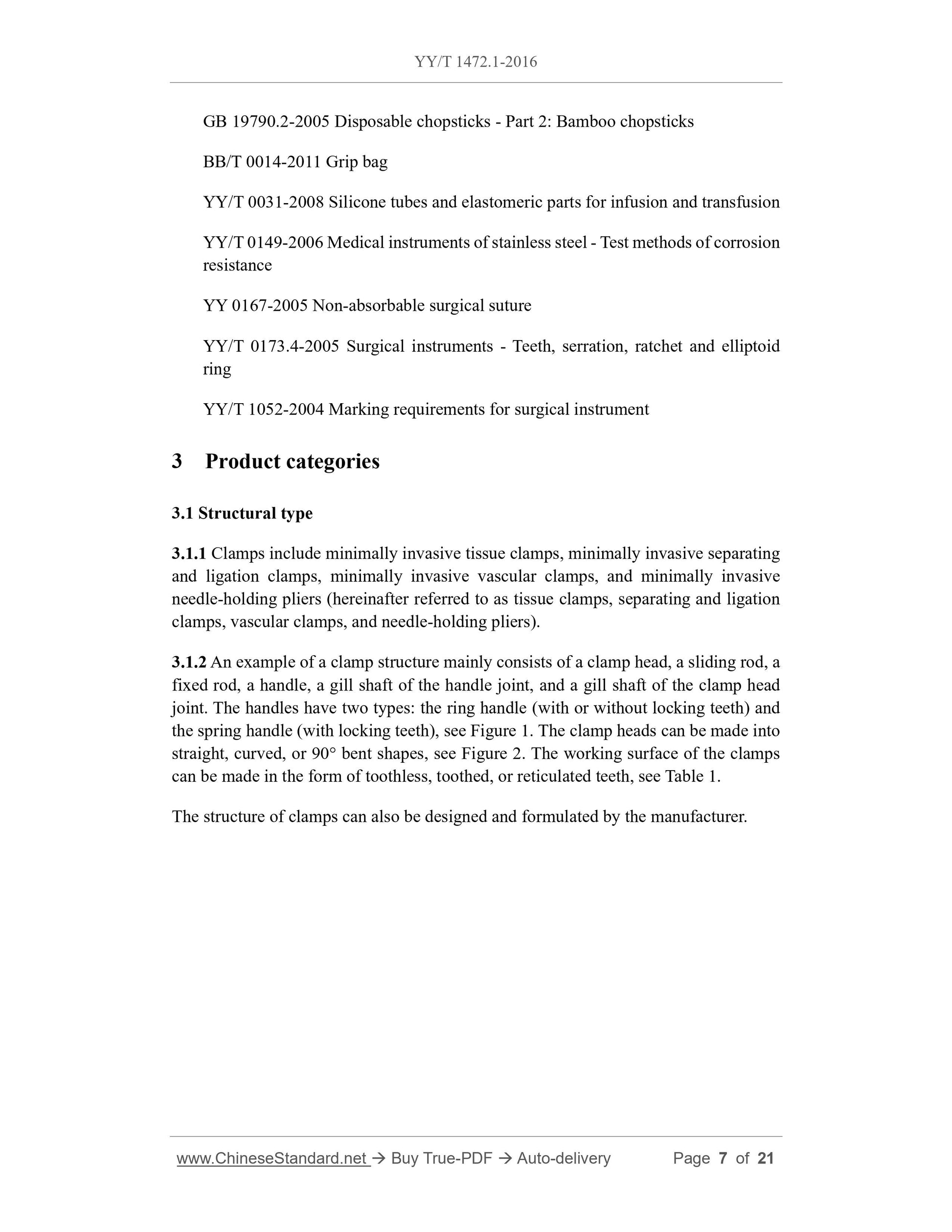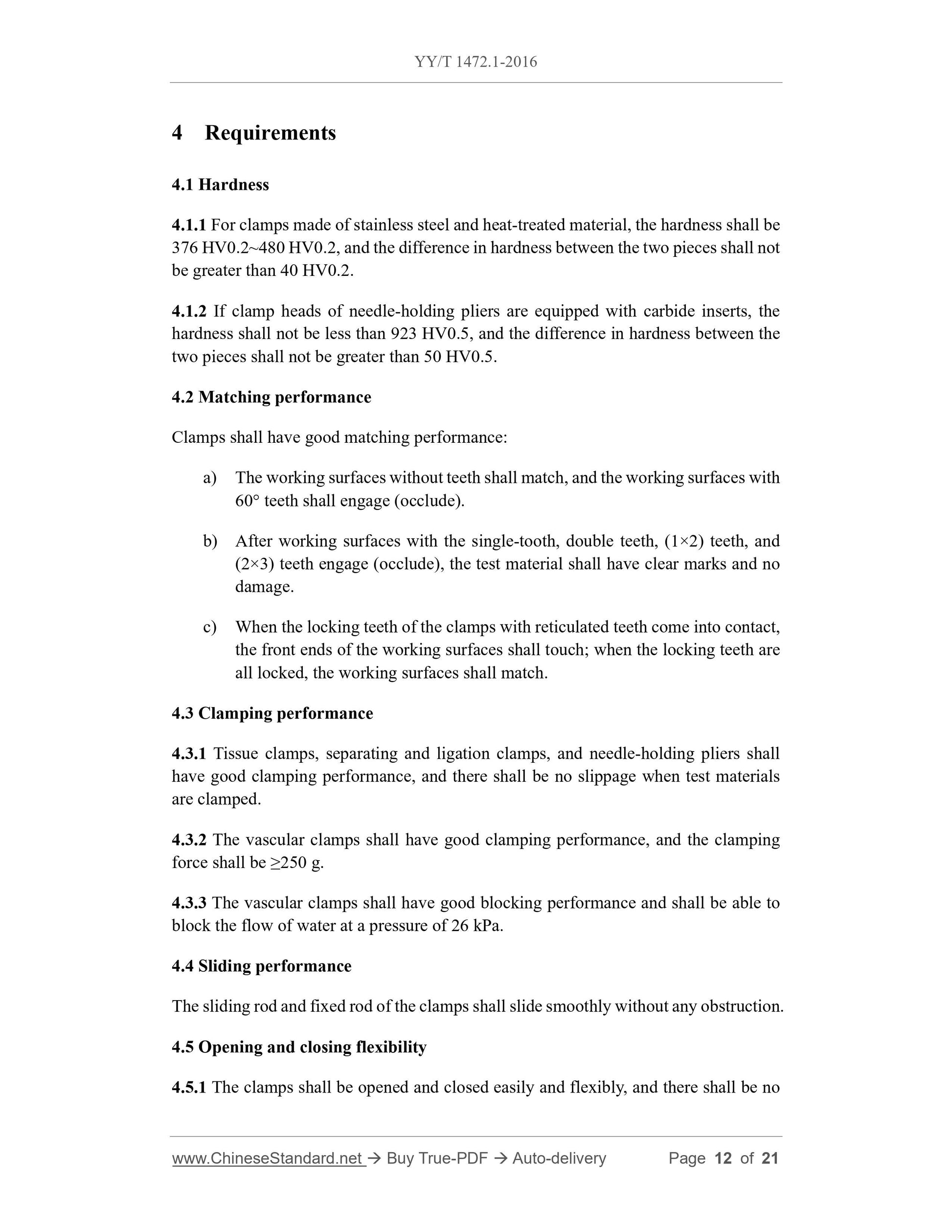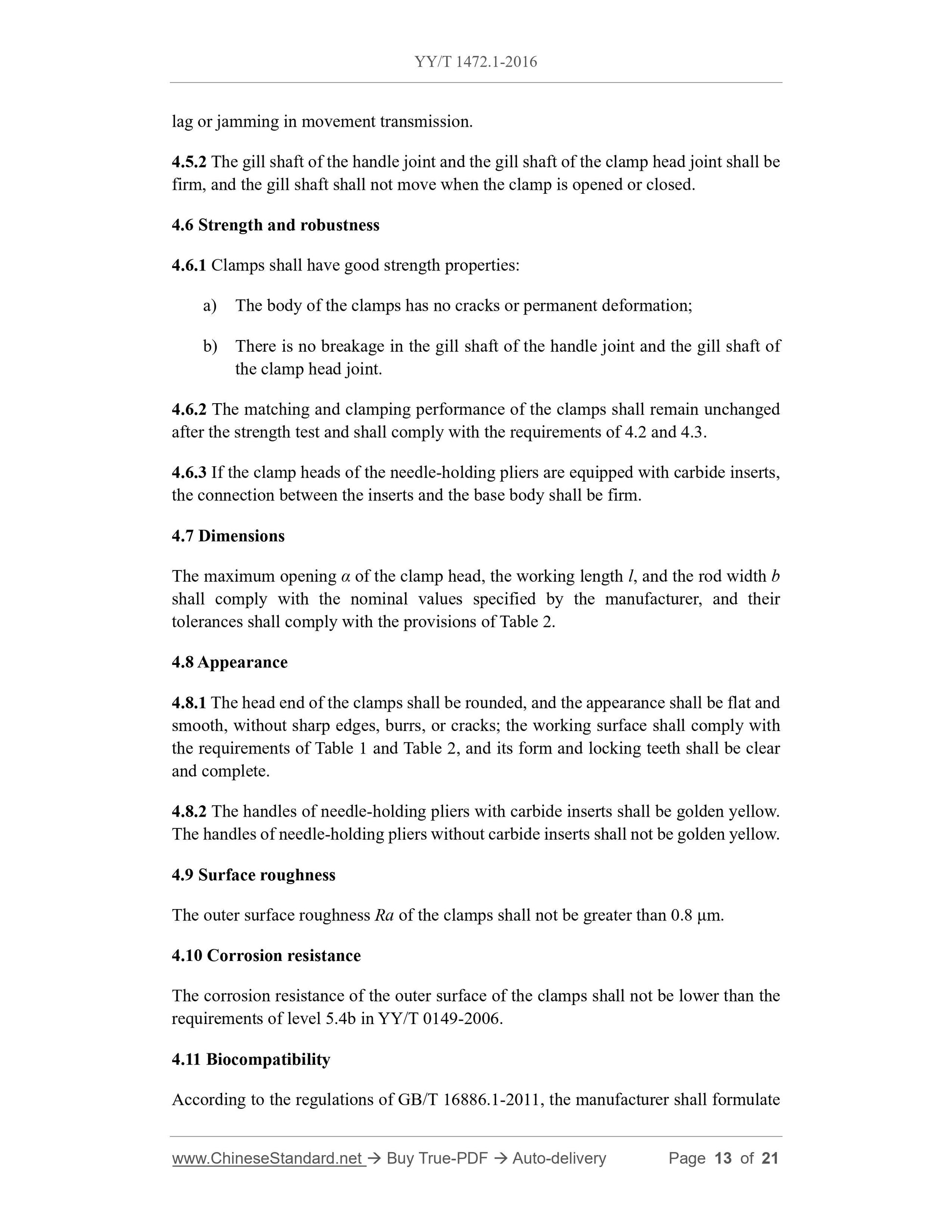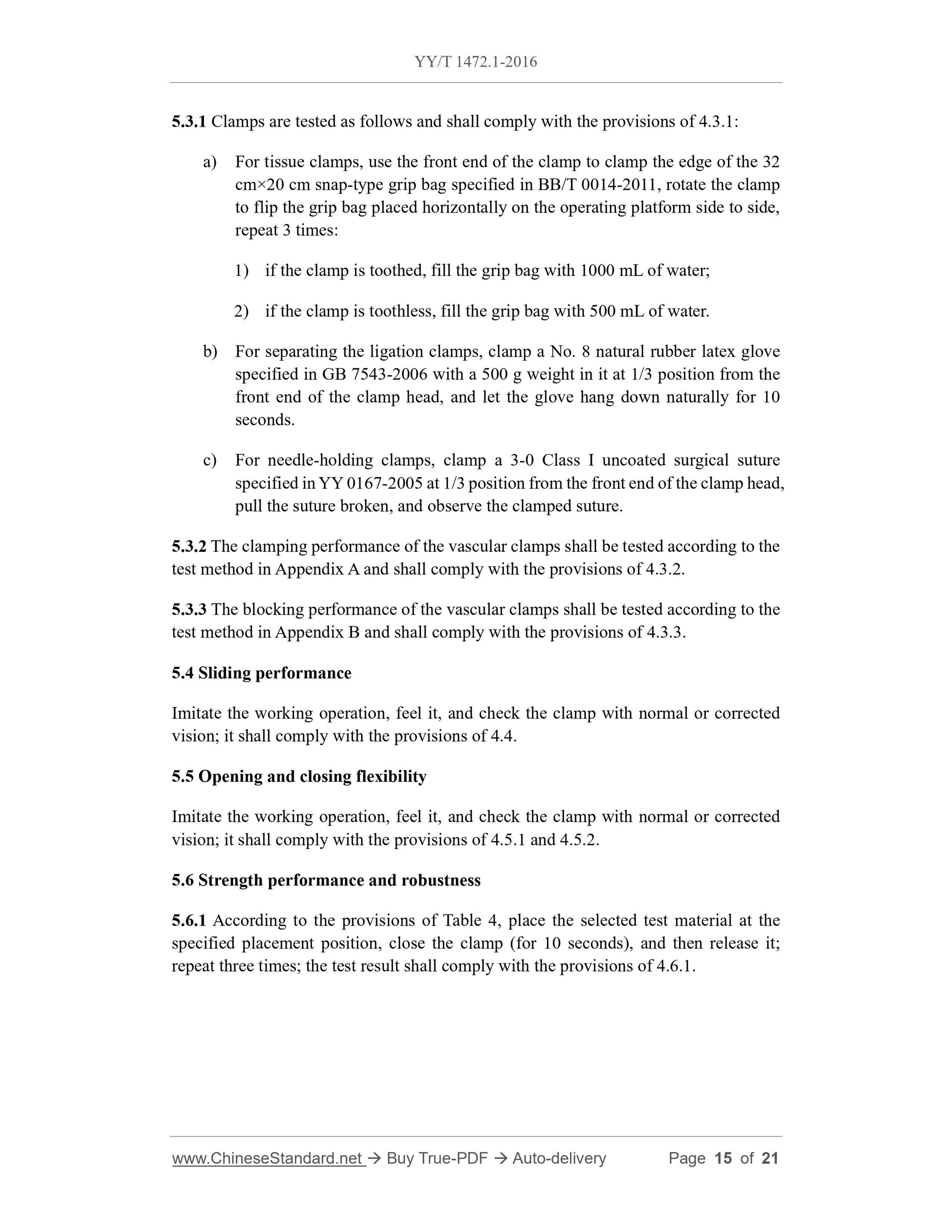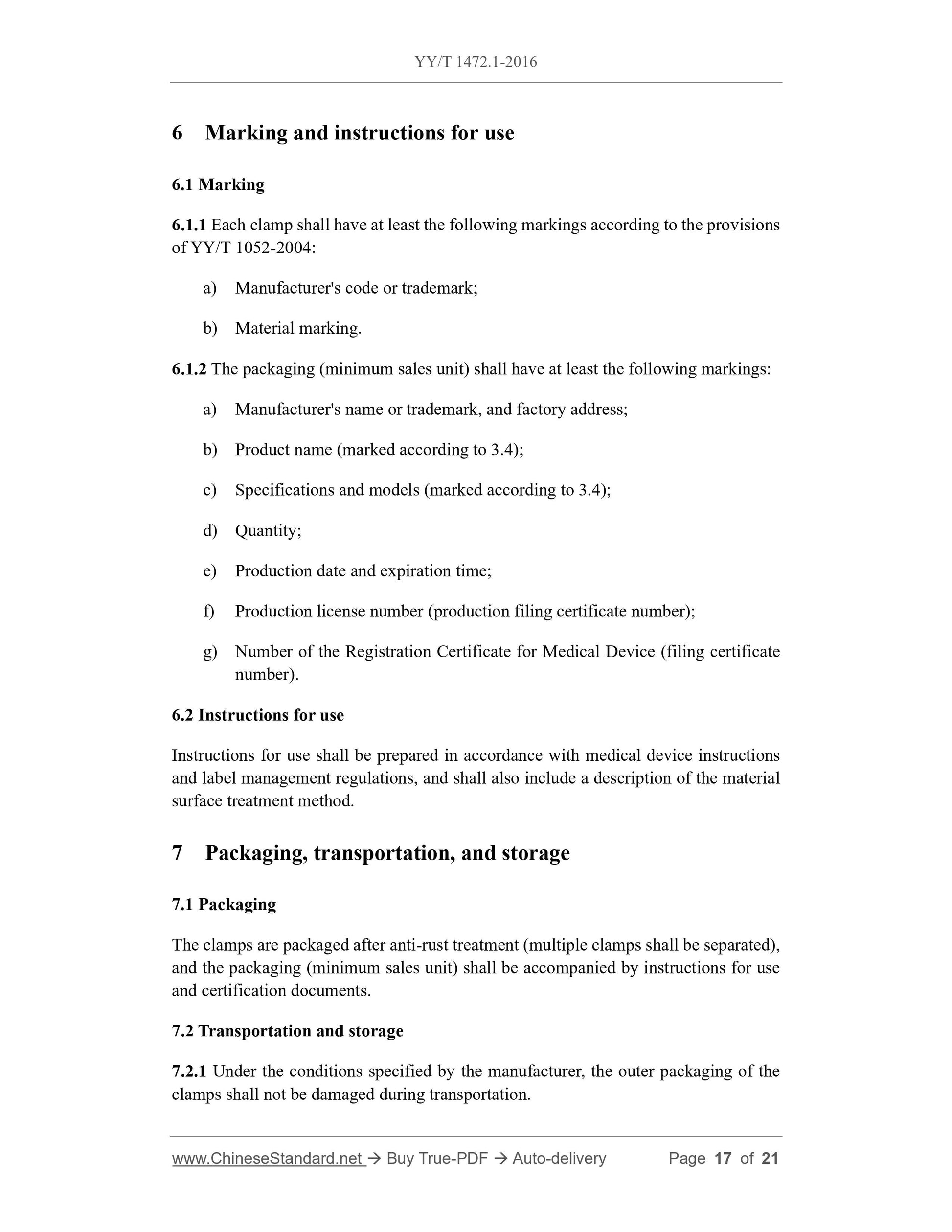1
/
의
8
PayPal, credit cards. Download editable-PDF and invoice in 1 second!
YY/T 1472.1-2016 English PDF (YYT1472.1-2016)
YY/T 1472.1-2016 English PDF (YYT1472.1-2016)
정가
$245.00 USD
정가
할인가
$245.00 USD
단가
/
단위
배송료는 결제 시 계산됩니다.
픽업 사용 가능 여부를 로드할 수 없습니다.
Delivery: 3 seconds. Download true-PDF + Invoice.
Get QUOTATION in 1-minute: Click YY/T 1472.1-2016
Historical versions: YY/T 1472.1-2016
Preview True-PDF (Reload/Scroll if blank)
YY/T 1472.1-2016: Thoracic minimally invasive instruments. Part 1: Dual pivot surgical clamps
YY/T 1472.1-2016
YY
PHARMACEUTICALS INDUSTRY STANDARD
OF THE PEOPLE'S REPUBLIC OF CHINA
ICS 11.040.30
C 36
Thoracic minimally invasive instruments - Part 1: Dual
pivot surgical clamps
ISSUED ON: JANUARY 26, 2016
IMPLEMENTED ON: JANUARY 1, 2017
Issued by: China Food and Drug Administration
Table of Contents
Foreword ... 3
Introduction ... 4
1 Scope ... 6
2 Normative references ... 6
3 Product categories ... 7
4 Requirements ... 12
5 Test methods ... 14
6 Marking and instructions for use ... 17
7 Packaging, transportation, and storage ... 17
Appendix A (Normative) Clamping performance test for vascular clamps ... 19
Appendix B (Normative) Clamping and blocking performance test for vascular clamps
... 20
Thoracic minimally invasive instruments - Part 1: Dual
pivot surgical clamps
1 Scope
This part of YY/T 1472 specifies the product classification, requirements, test methods,
inspection rules, markings, instructions for use, packaging, transportation, and storage
requirements for dual pivot surgical clamps.
This part applies to dual pivot surgical clamps (hereinafter referred to as clamps) for
use in thoracic minimally invasive surgery:
-- minimally invasive tissue clamps, used to clamp tissues and organs, such as lung
lobes and lymph nodes;
-- minimally invasive separating and ligation clamps, used to separate target organs,
such as blood vessels and tissues;
-- minimally invasive vascular clamps, used to clamp and block blood vessels;
-- minimally invasive needle-holding pliers, used to hold suture needles.
2 Normative references
The following documents are essential to the application of this document. For the dated
referenced documents, only the versions with the indicated dates are applicable to this
document; for the undated referenced documents, only the latest version (including all
the amendments) is applicable to this document.
GB/T 4237-2015 Hot rolled stainless steel plate, sheet and strip
GB/T 4240-2009 Stainless steel wires
GB/T 4340.1-2009 Metallic materials - Vickers hardness test - Part 1: Test method
GB 7543-2006 Single-use sterile rubber surgical gloves
GB/T 8938-2008 Typewriting paper
GB/T 16886.1-2011 Biological evaluation of medical devices - Part 1: Evaluation
and testing within a risk management process
GB 19790.2-2005 Disposable chopsticks - Part 2: Bamboo chopsticks
BB/T 0014-2011 Grip bag
YY/T 0031-2008 Silicone tubes and elastomeric parts for infusion and transfusion
YY/T 0149-2006 Medical instruments of stainless steel - Test methods of corrosion
resistance
YY 0167-2005 Non-absorbable surgical suture
YY/T 0173.4-2005 Surgical instruments - Teeth, serration, ratchet and elliptoid
ring
YY/T 1052-2004 Marking requirements for surgical instrument
3 Product categories
3.1 Structural type
3.1.1 Clamps include minimally invasive tissue clamps, minimally invasive separating
and ligation clamps, minimally invasive vascular clamps, and minimally invasive
needle-holding pliers (hereinafter referred to as tissue clamps, separating and ligation
clamps, vascular clamps, and needle-holding pliers).
3.1.2 An example of a clamp structure mainly consists of a clamp head, a sliding rod, a
fixed rod, a handle, a gill shaft of the handle joint, and a gill shaft of the clamp head
joint. The handles have two types: the ring handle (with or without locking teeth) and
the spring handle (with locking teeth), see Figure 1. The clamp heads can be made into
straight, curved, or 90° bent shapes, see Figure 2. The working surface of the clamps
can be made in the form of toothless, toothed, or reticulated teeth, see Table 1.
The structure of clamps can also be designed and formulated by the manufacturer.
4 Requirements
4.1 Hardness
4.1.1 For clamps made of stainless steel and heat-treated material, the hardness shall be
376 HV0.2~480 HV0.2, and the difference in hardness between the two pieces shall not
be greater than 40 HV0.2.
4.1.2 If clamp heads of needle-holding pliers are equipped with carbide inserts, the
hardness shall not be less than 923 HV0.5, and the difference in hardness between the
two pieces shall not be greater than 50 HV0.5.
4.2 Matching performance
Clamps shall have good matching performance:
a) The working surfaces without teeth shall match, and the working surfaces with
60° teeth shall engage (occlude).
b) After working surfaces with the single-tooth, double teeth, (1×2) teeth, and
(2×3) teeth engage (occlude), the test material shall have clear marks and no
damage.
c) When the locking teeth of the clamps with reticulated teeth come into contact,
the front ends of the working surfaces shall touch; when the locking teeth are
all locked, the working surfaces shall match.
4.3 Clamping performance
4.3.1 Tissue clamps, separating and ligation clamps, and needle-holding pliers shall
have good clamping performance, and there shall be no slippage when test materials
are clamped.
4.3.2 The vascular clamps shall have good clamping performance, and the clamping
force shall be ≥250 g.
4.3.3 The vascular clamps shall have good blocking performance and shall be able to
block the flow of water at a pressure of 26 kPa.
4.4 Sliding performance
The sliding rod and fixed rod of the clamps shall slide smoothly without any obstruction.
4.5 Opening and closing flexibility
4.5.1 The clamps shall be opened and closed easily and flexibly, and there shall be no
lag or jamming in movement transmission.
4.5.2 The gill shaft of the handle joint and the gill shaft of the clamp head joint shall be
firm, and the gill shaft shall not move when the clamp is opened or closed.
4.6 Strength and robustness
4.6.1 Clamps shall have good strength properties:
a) The body of the clamps has no cracks or permanent deformation;
b) There is no breakage in the gill shaft of the handle joint and the gill shaft of
the clamp head joint.
4.6.2 The matching and clamping performance of the clamps shall remain unchanged
after the strength test and shall comply with the requirements of 4.2 and 4.3.
4.6.3 If the clamp heads of the needle-holding pliers are equipped with carbide inserts,
the connection between the inserts and the base body shall be firm.
4.7 Dimensions
The maximum opening α of the clamp head, the working length l, and the rod width b
shall comply with the nominal values specified by the manufacturer, and their
tolerances shall comply with the provisions of Table 2.
4.8 Appearance
4.8.1 The head end of the clamps shall be rounded, and the appearance shall be flat and
smooth, without sharp edges, burrs, or cracks; the working surface shall comply with
the requirements of Table 1 and Table 2, and its form and locking teeth shall be clear
and complete.
4.8.2 The handles of needle-holding pliers with carbide inserts shall be golden yellow.
The handles of needle-holding pliers without carbide inserts shall not be golden yellow.
4.9 Surface roughness
The outer surface roughness Ra of the clamps shall not be greater than 0.8 μm.
4.10 Corrosion resistance
The corrosion resistance of the outer surface of the clamps shall not be lower than the
requirements of level 5.4b in YY/T 0149-2006.
4.11 Biocompatibility
According to the regulations of GB/T 16886.1-2011, the manufacturer shall formulate
5.3.1 Clamps are tested as follows and shall comply with the provisions of 4.3.1:
a) For tissue clamps, use the front end of the clamp to clamp...
Get QUOTATION in 1-minute: Click YY/T 1472.1-2016
Historical versions: YY/T 1472.1-2016
Preview True-PDF (Reload/Scroll if blank)
YY/T 1472.1-2016: Thoracic minimally invasive instruments. Part 1: Dual pivot surgical clamps
YY/T 1472.1-2016
YY
PHARMACEUTICALS INDUSTRY STANDARD
OF THE PEOPLE'S REPUBLIC OF CHINA
ICS 11.040.30
C 36
Thoracic minimally invasive instruments - Part 1: Dual
pivot surgical clamps
ISSUED ON: JANUARY 26, 2016
IMPLEMENTED ON: JANUARY 1, 2017
Issued by: China Food and Drug Administration
Table of Contents
Foreword ... 3
Introduction ... 4
1 Scope ... 6
2 Normative references ... 6
3 Product categories ... 7
4 Requirements ... 12
5 Test methods ... 14
6 Marking and instructions for use ... 17
7 Packaging, transportation, and storage ... 17
Appendix A (Normative) Clamping performance test for vascular clamps ... 19
Appendix B (Normative) Clamping and blocking performance test for vascular clamps
... 20
Thoracic minimally invasive instruments - Part 1: Dual
pivot surgical clamps
1 Scope
This part of YY/T 1472 specifies the product classification, requirements, test methods,
inspection rules, markings, instructions for use, packaging, transportation, and storage
requirements for dual pivot surgical clamps.
This part applies to dual pivot surgical clamps (hereinafter referred to as clamps) for
use in thoracic minimally invasive surgery:
-- minimally invasive tissue clamps, used to clamp tissues and organs, such as lung
lobes and lymph nodes;
-- minimally invasive separating and ligation clamps, used to separate target organs,
such as blood vessels and tissues;
-- minimally invasive vascular clamps, used to clamp and block blood vessels;
-- minimally invasive needle-holding pliers, used to hold suture needles.
2 Normative references
The following documents are essential to the application of this document. For the dated
referenced documents, only the versions with the indicated dates are applicable to this
document; for the undated referenced documents, only the latest version (including all
the amendments) is applicable to this document.
GB/T 4237-2015 Hot rolled stainless steel plate, sheet and strip
GB/T 4240-2009 Stainless steel wires
GB/T 4340.1-2009 Metallic materials - Vickers hardness test - Part 1: Test method
GB 7543-2006 Single-use sterile rubber surgical gloves
GB/T 8938-2008 Typewriting paper
GB/T 16886.1-2011 Biological evaluation of medical devices - Part 1: Evaluation
and testing within a risk management process
GB 19790.2-2005 Disposable chopsticks - Part 2: Bamboo chopsticks
BB/T 0014-2011 Grip bag
YY/T 0031-2008 Silicone tubes and elastomeric parts for infusion and transfusion
YY/T 0149-2006 Medical instruments of stainless steel - Test methods of corrosion
resistance
YY 0167-2005 Non-absorbable surgical suture
YY/T 0173.4-2005 Surgical instruments - Teeth, serration, ratchet and elliptoid
ring
YY/T 1052-2004 Marking requirements for surgical instrument
3 Product categories
3.1 Structural type
3.1.1 Clamps include minimally invasive tissue clamps, minimally invasive separating
and ligation clamps, minimally invasive vascular clamps, and minimally invasive
needle-holding pliers (hereinafter referred to as tissue clamps, separating and ligation
clamps, vascular clamps, and needle-holding pliers).
3.1.2 An example of a clamp structure mainly consists of a clamp head, a sliding rod, a
fixed rod, a handle, a gill shaft of the handle joint, and a gill shaft of the clamp head
joint. The handles have two types: the ring handle (with or without locking teeth) and
the spring handle (with locking teeth), see Figure 1. The clamp heads can be made into
straight, curved, or 90° bent shapes, see Figure 2. The working surface of the clamps
can be made in the form of toothless, toothed, or reticulated teeth, see Table 1.
The structure of clamps can also be designed and formulated by the manufacturer.
4 Requirements
4.1 Hardness
4.1.1 For clamps made of stainless steel and heat-treated material, the hardness shall be
376 HV0.2~480 HV0.2, and the difference in hardness between the two pieces shall not
be greater than 40 HV0.2.
4.1.2 If clamp heads of needle-holding pliers are equipped with carbide inserts, the
hardness shall not be less than 923 HV0.5, and the difference in hardness between the
two pieces shall not be greater than 50 HV0.5.
4.2 Matching performance
Clamps shall have good matching performance:
a) The working surfaces without teeth shall match, and the working surfaces with
60° teeth shall engage (occlude).
b) After working surfaces with the single-tooth, double teeth, (1×2) teeth, and
(2×3) teeth engage (occlude), the test material shall have clear marks and no
damage.
c) When the locking teeth of the clamps with reticulated teeth come into contact,
the front ends of the working surfaces shall touch; when the locking teeth are
all locked, the working surfaces shall match.
4.3 Clamping performance
4.3.1 Tissue clamps, separating and ligation clamps, and needle-holding pliers shall
have good clamping performance, and there shall be no slippage when test materials
are clamped.
4.3.2 The vascular clamps shall have good clamping performance, and the clamping
force shall be ≥250 g.
4.3.3 The vascular clamps shall have good blocking performance and shall be able to
block the flow of water at a pressure of 26 kPa.
4.4 Sliding performance
The sliding rod and fixed rod of the clamps shall slide smoothly without any obstruction.
4.5 Opening and closing flexibility
4.5.1 The clamps shall be opened and closed easily and flexibly, and there shall be no
lag or jamming in movement transmission.
4.5.2 The gill shaft of the handle joint and the gill shaft of the clamp head joint shall be
firm, and the gill shaft shall not move when the clamp is opened or closed.
4.6 Strength and robustness
4.6.1 Clamps shall have good strength properties:
a) The body of the clamps has no cracks or permanent deformation;
b) There is no breakage in the gill shaft of the handle joint and the gill shaft of
the clamp head joint.
4.6.2 The matching and clamping performance of the clamps shall remain unchanged
after the strength test and shall comply with the requirements of 4.2 and 4.3.
4.6.3 If the clamp heads of the needle-holding pliers are equipped with carbide inserts,
the connection between the inserts and the base body shall be firm.
4.7 Dimensions
The maximum opening α of the clamp head, the working length l, and the rod width b
shall comply with the nominal values specified by the manufacturer, and their
tolerances shall comply with the provisions of Table 2.
4.8 Appearance
4.8.1 The head end of the clamps shall be rounded, and the appearance shall be flat and
smooth, without sharp edges, burrs, or cracks; the working surface shall comply with
the requirements of Table 1 and Table 2, and its form and locking teeth shall be clear
and complete.
4.8.2 The handles of needle-holding pliers with carbide inserts shall be golden yellow.
The handles of needle-holding pliers without carbide inserts shall not be golden yellow.
4.9 Surface roughness
The outer surface roughness Ra of the clamps shall not be greater than 0.8 μm.
4.10 Corrosion resistance
The corrosion resistance of the outer surface of the clamps shall not be lower than the
requirements of level 5.4b in YY/T 0149-2006.
4.11 Biocompatibility
According to the regulations of GB/T 16886.1-2011, the manufacturer shall formulate
5.3.1 Clamps are tested as follows and shall comply with the provisions of 4.3.1:
a) For tissue clamps, use the front end of the clamp to clamp...
Share
